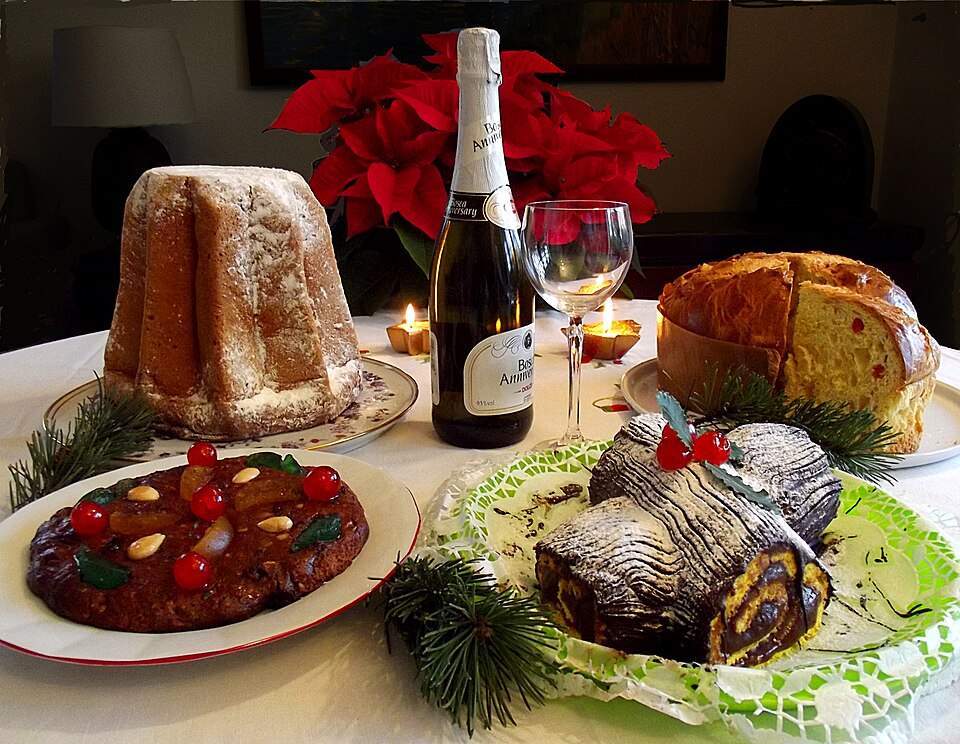
Italian Christmas Food Guide: Traditional Holiday Dishes and Recipes
Why Italian Christmas Food is… Different
Okay, let’s be honest here. Italian Christmas food isn’t just about one big meal on December 25th. It’s more like… a month-long culinary marathon that somehow manages to be both deeply traditional and completely chaotic. I mean, we’re talking about a culture that takes three hours to eat Christmas Eve dinner, argues passionately about whether panettone or pandoro is superior, and considers it perfectly normal to serve seven different fish dishes in one sitting.
What strikes me most about Italian Christmas cuisine is how it reflects the country’s incredible regional diversity. A Christmas table in Naples looks completely different from one in Milan, and both are worlds apart from what you’d find in a Tuscan farmhouse. Yet somehow, they’re all unmistakably Italian—bound together by this shared understanding that food isn’t just fuel, it’s the centerpiece of celebration, memory, and family connection.
La Vigilia di Natale: The Famous Feast of Seven Fishes
If there’s one Italian Christmas tradition that confuses and delights visitors in equal measure, it’s La Vigilia di Natale—Christmas Eve’s Feast of Seven Fishes. Now, before you start counting on your fingers, let me save you some time: the “seven” isn’t really set in stone. Some families serve seven dishes, others do nine, eleven, or however many the cook feels like preparing. The number supposedly represents the seven sacraments, but honestly? Most Italian families I know just keep cooking until the table can’t hold any more plates.
This tradition stems from the Catholic practice of abstaining from meat on Christmas Eve—a fast that gets broken in the most spectacular way possible on Christmas Day. Southern Italy, especially, embraces this seafood feast with enthusiasm that borders on the theatrical. We’re talking multiple courses: antipasti featuring marinated anchovies and stuffed calamari, pasta dishes like spaghetti alle vongole or linguine with lobster, and elaborate preparations of everything from baccalà (salt cod) to capitone (eel).
Essential Feast of Seven Fishes Dishes
Baccalà appears on virtually every Christmas Eve table, prepared in countless regional variations. In Rome, you might find baccalà mantecato—a creamy, whipped preparation served on crostini. In Sicily, it’s often prepared in agrodolce (sweet and sour sauce) with raisins and pine nuts. The preparation starts days ahead, with the salt cod soaking in water to remove the salt.
Capitone (eel) holds special significance, traditionally considered lucky for the new year. Naples takes this seriously—Christmas Eve eel vendors set up throughout the city, and families line up to select their eels live from tanks. It’s prepared in dozens of ways: grilled, roasted, fried, or braised with tomatoes and herbs.
Spaghetti alle vongole might seem simple, but Christmas Eve versions often get elevated with bottarga (cured fish roe), extra herbs, or a splash of prosecco. The key is using the freshest clams possible—Italian cooks can tell you exactly which fishing boats brought them in and when.
Christmas Day: When the Meat Comes Out
After Christmas Eve’s seafood extravaganza, December 25th brings a complete shift in Italian kitchens. This is when families break out the recipes that have been passed down for generations—the ones that require starting preparation at dawn and filling the house with aromas that somehow spell “Christmas” in every dialect from Turin to Palermo.
Tortellini in brodo appears on Christmas tables throughout Emilia-Romagna and beyond. These tiny, hat-shaped pasta parcels, traditionally filled with a mixture of pork, prosciutto, and Parmigiano-Reggiano, swim in a rich, golden broth that’s been simmering since early morning. Making tortellini is often a family affair—multiple generations gathering around kitchen tables, rolling pasta thin and folding each piece by hand while catching up on a year’s worth of gossip.
Central Italy tends toward roasted meats for Christmas Day. Agnello (lamb) appears frequently, often studded with garlic and rosemary, roasted until the outside is crispy and the inside remains tender. In Tuscany, you might find cinghiale (wild boar) or a magnificent bistecca alla fiorentina if the family’s feeling particularly festive.
Northern regions often feature bollito misto—a selection of boiled meats served with salsa verde and mostarda di Cremona. It sounds humble, but when done properly, with quality cuts of beef, veal, chicken, and cotechino sausage, it becomes something approaching poetry.
The Great Panettone vs. Pandoro Debate
Nothing—and I mean nothing—divides Italian Christmas tables quite like the panettone versus pandoro question. It’s Milan versus Verona, candied fruits versus powdered sugar, tall dome versus star shape. Families have been arguing about this for decades, and honestly, I don’t see it getting resolved anytime soon.
Panettone, Milan’s contribution to Italian Christmas, is that towering, dome-shaped sweet bread studded with candied orange peel, citron, and raisins. Traditional versions require a natural yeast starter that takes days to develop, multiple rises, and enough patience to drive most home bakers to distraction. The result, when done properly, is a light, airy bread with complex flavors that pair beautifully with espresso, vin santo, or a glass of spumante.
Pandoro, Verona’s answer to Milan’s dominance, takes a different approach entirely. This eight-pointed star-shaped cake contains no fruits—just eggs, butter, sugar, and flour transformed through careful technique into something that practically melts on your tongue. It’s traditionally dusted with powdered sugar (meant to resemble the Alps in winter) and served in thick slices that disappear faster than you’d expect.
The rivalry between these two sweets reflects deeper regional differences in Italian cuisine. Panettone represents the international, cosmopolitan approach of northern Italy’s commercial capital. Pandoro embodies the more refined, technique-focused traditions of Veneto’s artisanal culture. Both are delicious. Choose based on whether you prefer fruit or pure, buttery indulgence—or just buy both and let your guests fight it out.
Regional Christmas Specialties: A Culinary Tour of Italy
One of the most fascinating aspects of Italian Christmas food is how dramatically it changes as you move from region to region. It’s like each area took the basic framework of Christmas and added its own cultural DNA, creating dishes that are unmistakably local yet part of the larger Italian holiday tradition.
Northern Italy: Alpine Influences and Hearty Traditions
Up north, Christmas food reflects both Alpine influences and the region’s history of Austrian and Germanic connections. Cotechino con lenticchie appears on many Lombardy and Veneto tables—a rich, spiced sausage served with lentils that supposedly bring luck and prosperity for the new year.
Piedmont contributes agnolotti del plin, tiny pasta parcels traditionally filled with roasted meats and vegetables, served in butter sauce or rich broth. The name means “pinched” in Piemontese dialect, referring to the technique used to seal these delicate pasta packages.
In South Tyrol, Christmas markets feature zelten, a dense fruitcake packed with dried fruits, nuts, and spices that reflects the region’s Germanic heritage. It’s often served with a glass of grappa or vin brulé (mulled wine) that warms you from the inside out.
Central Italy: Roman Grandeur and Tuscan Simplicity
Central Italian Christmas food tends to balance the elaborate and the rustic, often within the same meal. Rome’s contribution includes abbacchio (milk-fed lamb) roasted with rosemary and garlic, and maritozzi—sweet buns filled with whipped cream that appear on Christmas breakfast tables throughout Lazio.
Tuscany keeps things characteristically simple but perfect. Ribollita might appear on Christmas Eve tables—that famous “twice-boiled” soup made with bread, beans, and whatever vegetables are in season. Christmas Day might feature arista di maiale, a pork roast seasoned with garlic, rosemary, and fennel that fills Tuscan kitchens with incredible aromas.
Umbria contributes torciglione, an almond-based Christmas cake shaped like a snake and covered in chocolate or colored sugar. It’s both beautiful and delicious—typical of Umbrian holiday traditions that prioritize both visual appeal and flavor.
Southern Italy and Islands: Intense Flavors and Ancient Traditions
The south is where Italian Christmas food really gets passionate. Struffoli from Campania are tiny fried dough balls covered in honey and colorful sprinkles, formed into wreaths or trees that become edible centerpieces. Making struffoli is traditionally women’s work, with mothers, daughters, and aunts gathering to roll thousands of tiny balls by hand.
Sicily brings cassata to Christmas tables—that magnificent dessert featuring ricotta, candied fruits, chocolate, and liqueur enclosed in sponge cake or marzipan. Each family has their own version, and recipes are guarded more carefully than family secrets.
Calabria offers ‘nduja, that fiery spreadable salami that transforms any Christmas antipasti platter into something memorable. It’s often served on crostini or stirred into pasta for those who like their holidays with a bit of heat.
Sardinia contributes pardulas, cheese-filled pastries flavored with lemon zest and saffron that represent the island’s unique culinary heritage—neither quite Italian nor entirely its own thing, but absolutely delicious.
Christmas Breakfast and Holiday Sweets
Italian Christmas morning often starts quietly, with families gathering around kitchen tables for a breakfast that bridges the excitement of Christmas Eve and the anticipated feast of Christmas lunch. Pandoro or panettone appear alongside strong coffee, often with a glass of prosecco for those who believe Christmas deserves a bit of sparkle from the moment you wake up.
Mostaccioli are hard, spiced cookies that appear throughout southern Italy during the Christmas season. Covered in chocolate or colorful icing, they’re designed to last for weeks—perfect for the extended Italian Christmas season that stretches through Epiphany on January 6th.
Ricciarelli from Siena are almond-based cookies that melt in your mouth, traditionally made with bitter almonds and covered in powdered sugar. They’re often shaped like eyes (the name means “little curls”), and their texture is completely different from the crunchy cookies Americans might expect.
Panforte, also from Siena, is more like a dense, spiced candy than a cake. Packed with nuts, candied fruits, and spices, it’s incredibly rich—a small slice provides enough intensity to satisfy the sweetest tooth. Traditionally, panforte improves with age, making it perfect for a holiday season that extends over nearly a month.
The Art of Italian Christmas Cooking: Tips and Techniques
Cooking an authentic Italian Christmas meal requires understanding that timing matters as much as ingredients. Most dishes benefit from advance preparation—sauces that simmer for hours, breads that rise slowly, meats that marinate overnight. Italian Christmas cooking isn’t about rushed preparation; it’s about creating layers of flavor that develop over time.
Start your brodo early. That golden, rich broth that makes tortellini sing doesn’t happen in an hour. Good Italian cooks start their Christmas broth the day before, using a combination of beef, chicken, and vegetables simmered slowly until the liquid turns deep gold and tastes like concentrated comfort.
Quality ingredients make the difference. Italian Christmas cooking relies on fewer, better ingredients rather than complex preparations. This means finding the best olive oil you can afford, buying Parmigiano-Reggiano from a reliable source, and selecting fish and meat from trusted suppliers. When you’re serving baccalà as the centerpiece of Christmas Eve, the quality of that salt cod determines whether your meal is memorable or forgettable.
Embrace the chaos. Italian Christmas kitchens are busy, loud places where multiple generations work together, argue about seasoning, and somehow produce incredible meals despite what looks like complete disorder. The key is organization and acceptance that nothing will go exactly according to plan—and that’s perfectly fine.
Wine and Beverages: Pairing Drinks with Italian Christmas Foods
Italian Christmas meals demand wines that can stand up to rich, complex flavors while enhancing rather than overwhelming the food. Prosecco appears on most Christmas tables, served as an aperitivo with antipasti or alongside panettone at breakfast. Its crisp bubbles and subtle fruit flavors provide a perfect counterpoint to rich holiday foods.
For the Feast of Seven Fishes, many Italian families choose Pinot Grigio or Vermentino—white wines with enough acidity to complement seafood without masking delicate flavors. Some regions prefer local varieties: Falanghina in Campania, Greco di Tufo in areas where Greek influence runs deep.
Christmas Day’s meat courses call for more substantial wines. Chianti Classico pairs beautifully with roasted lamb or wild boar, while northern regions might pour Barolo or Amarone with their bollito misto or brasato al Barolo.
Don’t forget digestivi. Italian Christmas meals end with amaro, grappa, or limoncello—traditional digestive aids that also provide an excuse to extend the meal just a little longer, giving family members more time to argue about politics, gossip about neighbors, and plan next year’s menu.
Modern Italian Christmas: Tradition Meets Contemporary Life
Today’s Italian Christmas cooks face the same challenges as home cooks everywhere: less time, busier schedules, and family members with different dietary preferences. Yet somehow, the essential character of Italian Christmas food persists. Modern Italian families might buy high-quality panettone from a local bakery instead of making it from scratch, but they still gather for those long, leisurely meals that define the season.
Many Italian families now incorporate international influences into their Christmas menus—perhaps adding Asian-inspired flavors to seafood dishes or experimenting with fusion approaches to traditional sweets. But these additions rarely replace traditional dishes; they expand the celebration while maintaining its core identity.
The rise of food allergies and dietary restrictions has pushed Italian Christmas cooking to become more inclusive without losing authenticity. Gluten-free versions of traditional sweets appear alongside original recipes, and vegetarian alternatives to meat courses gain acceptance, especially among younger generations.
Planning Your Italian Christmas Menu
Creating an authentic Italian Christmas meal requires planning that starts weeks in advance. Begin with the centerpiece—will you focus on Christmas Eve’s seafood tradition or Christmas Day’s meat-centered feast? Your decision influences everything from shopping to preparation timeline.
For a traditional Christmas Eve menu:
– Start with antipasti: marinated olives, stuffed peppers, anchovy crostini
– First course: spaghetti alle vongole or linguine with seafood
– Main courses: baccalà prepared your preferred way, plus 2-3 additional fish dishes
– Dessert: panettone or pandoro with prosecco
– Wine: crisp whites that complement seafood
For a Christmas Day feast:
– Begin with prosecco and light antipasti
– First course: tortellini in brodo or regional pasta specialty
– Main course: roasted lamb, pork, or regional meat tradition
– Sides: roasted vegetables, seasonal salads
– Dessert: traditional sweets plus seasonal fruits
– Wine: robust reds that pair with meat courses
Remember that Italian Christmas meals are marathons, not sprints. Plan for 3-4 hours at the table, with breaks between courses for digestion, conversation, and perhaps a short walk around the neighborhood to make room for the next course.
The Cultural Heart of Italian Christmas Food
What makes Italian Christmas food special isn’t just the recipes—it’s the understanding that food serves as the foundation for everything else the season represents. These meals create the stage where families reconnect, stories get shared, and traditions pass from one generation to the next.
Italian Christmas cooking embodies patience in a world that increasingly values speed, craftsmanship in an era of convenience, and the belief that some things—family, tradition, the perfect bite of tortellini—are worth preserving even when they require significant time and effort.
While enjoying these festive meals, impress your Italian hosts by saying Merry Christmas in Italian—it shows respect for both the language and the culture that created these incredible food traditions.
Related Italian Holiday Experiences
- Italian Christmas Traditions and Customs: A Complete Cultural Guide
- Celebrating Christmas in Italy: Your Holiday Travel Guide
- Complete Italian Christmas Vocabulary: Beyond Merry Christmas
- Italian Christmas Cards and Holiday Messages: What to Write
- Italian New Year Greetings and Traditions: Buon Anno Guide
You May Also Like

5 Amazing Places in Japan for First Timers
September 7, 2015
6 Unmissable Routes in the UK
February 16, 2022





